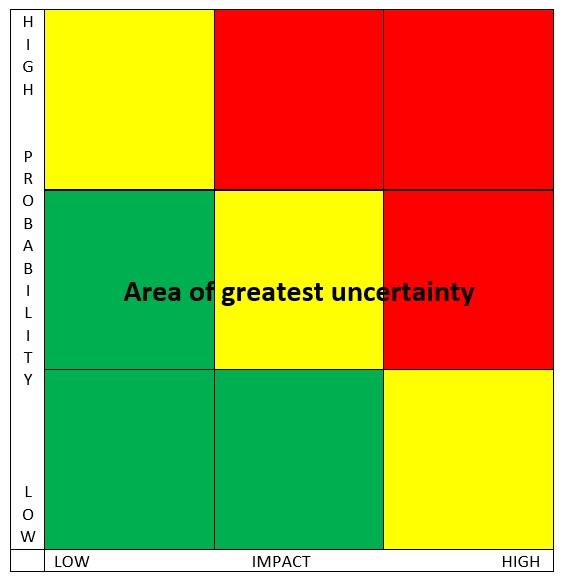Author: Manu Steens
In this article I write my own opinion, not that of any organization.
Contents
Risk Management
On the one hand, we have risk management.
In risk management, it is common practice to translate a risk as a product of probability and impact. The most well-known formula for measuring a risk is:
R = P * I
R is the measure of risk, P the measure of the probability of an undesirable event occurring and I its impact on achieving the objectives of the organization. Both are considered known.
Special attention in this article is paid to the situation in which there is a high degree of uncertainty with a risk. Unlike certainty, usually mathematically defined as a number between 0 and 1, or between 0% and 100%, uncertainty is rather something we feel but on which we cannot attach a clear mathematical definition that leans back on certainty. What we do know, however, is when the uncertainty is maximum for the occurrence of an event as a result of a cause. That is if the probability is 50%. Why? Because then the occurrence of the event is a coin on its side: you really do not know which way it will fall.

Scenario Thinking and Future Planning
On the other hand, we have the combination of the future strategies with scenario thinking.
In itself, risk management is also a bit like thinking towards the future: if the probability is high, for example 95% chance of occurrence, then there is a relative high certainty of the occurrence of the impact. It is then, from risk management and in function of the impact, that one has to define and implement a measure. This allows the impact to be optimally prevented or mitigated (in the event of a threat) or provoked to the maximum (in the event of an opportunity).
Uncertainty
However, the reasoning I want to make here is this one where the uncertainty is maximum. There it is therefore unclear whether the event will occur, or not. So a twofold future occurs: the event happens or does not happen. With this, a game of extremes occurs, for example:
- Will it be war or peace?
- Will healthcare become more preventive or more curative?
- Will sufficient measures be taken in time for the climate or will it become an unbearable climate?
- Will there be famine or abundance?
With such uncertainties one can consider these uncertainties in their own right, where one has two futures per uncertainty, or one can express them per two against each other (if they are sufficiently independent), obtaining quadrants that represent four futures.
In theory one can work with n uncertainties, where one then obtains 2n futures but it becomes problematic, because already from n = 3 one has 8 futures, which becomes unworkable and also because in practice it becomes more difficult to maintain the independence of these uncertainties. And that is necessary to foresee extremely different futures.
For each of these futures, instead of directly defining measures, one can then start thinking about scenarios. This is a strategic choice, where one defines how one will act in a certain direction depending on which future becomes true. This instead of putting a single project or action in the pipeline because one has a strong expectation regarding whether (probability rather high) or not (probability rather low) the event with a specific impact will occur.
Lowering the uncertainty about the knowledge of the future
In order to be able to make the right choice, it is necessary to explore the evolution of the circumstances of the organization. In other words, lowering the uncertainty about the knowledge of the future. To do that, one has a number of things that one can do.
- The very first thing to do is to dare to question the assumptions. Are the assumptions that were made the good ones.
- One determines the extreme futures, the scenarios, and whether one is ready for it, or whether, in contrast, one still has work to do. Usually it is the latter. To this end, one looks at which strategic option is most useful in which possible future. These options involve developing possible future projects or actions, and thoroughly considering their effects with a 360° view. As far as possible, tests or exercises are carried out to estimate the possible effects. What are the shortcomings that need to be filled in?
- Furthermore, there is the collection of the necessary information. One will define relevant parameters – indicators – and follow their trends. One determines in advance when one will decide on the basis of which (combination of) indicators which strategic options one will roll out. This is important, because being there in time and preparing for a future can determine whether one can get a competitive or societal advantage from it or whether one is more likely to encounter a problem.
- When the future unfolds, one deliberately monitors it, and consciously chooses the pre-agreed options tailored to the actual nuanced future. The timing of the decision and the roll-out of action plans is then crucial.
Conclusion
Scenario thinking and future planning are relevant within risk management. However, one should have a good idea when this is the case. A rule of thumb is: do this with priority where the probability of an event with a certain impact is average.
Usually there are multiple risks with an average probability. Then give priority to risks with a high impact. After all, these give a more extreme course of the possible futures. As much as possible, make sure that you work with uncertainties that are maximally independent of each other if you plot them against each other.
However, if the impact is very large, and opportunities exist to influence the probabilities in your favor, do not fail to do so with common risk management strategies. “Choose your battles wisely.” After all, future planning and scenario thinking are especially useful when the internal and / or external environment of the organization are substantially uncertain. The choice to work on certainty, or to try to take advantage of uncertainty, is also a strategic choice in itself. And that depends on the capabilities of the organization. The internal environment can usually be influenced. Tinkering with the external environment is usually an impossible task. That is why this technique is also important when trying to look at risk management objectively for the organization as part of the world.

